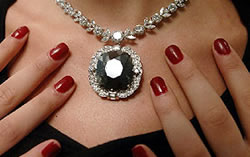The Curse of the Black Orlov Diamond

Introduction
Often mistaken for being purely black, this legendary diamond features deep "gun-metal" tones that reflect a shadowy history. It starts with a theft from a Hindu idol and ties into at least three mysterious suicides. You might find yourself drawn into the drama as we explore its path.
The Black Orlov Diamond, also known as the Eye of Brahma Diamond, weighs 67.50 carats. Its story traces back to 19th-century India, where it was part of a larger 195-carat uncut diamond. If you're interested in learning more about diamonds in general, explore our detailed diamond information resource.
Origins in India
Legend holds that this diamond served as one of the eyes on a statue of Brahma, the Hindu god of creation, in a shrine in Pondicherry, southern India. A wandering monk reportedly stole it, sparking a curse that has followed the stone ever since.
While skeptics dismiss the curse as mere folklore, the diamond's journey remains filled with mystery, drama, and tragedy.
Arrival in the United States and J.W. Paris
In 1932, a European diamond dealer named J.W. Paris brought the stone to the United States to find a buyer. Details about Paris are scarce, but within a week of reaching New York, he sold it. Soon after, on April 7, he climbed to the top of a Manhattan skyscraper on 5th Avenue and jumped to his death. Some call him the first victim of the diamond's curse.
Rumors suggest Paris faced severe anxiety from business troubles. At his death, he carried two letters - one to his wife and one to a fellow jeweler - but their contents stayed private.
Princess Nadia Vygin-Orlov
Around the early 20th century, the diamond belonged to Russian Princess Nadia Vygin-Orlov, who gave it its name through later events.
During the 1917 Russian Revolution, she escaped to Rome, Italy, like many royals. On December 2, 1947 - 15 years after Paris's death - she jumped from a building in central Rome in an apparent suicide. At the time, she was married to a Russian jeweler, but few details exist about her final circumstances.

Princess Leonila Viktorovna-Bariatinsky
Just one month before Nadia's death, another Russian royal, Princess Leonila Viktorovna-Bariatinsky, also jumped to her death in a suspected suicide. She was married to Royal Navy Officer Prince Andre Glinstine, but little is known about her life then. It later emerged that she had owned the Black Orlov Diamond before her end.
The White Orlov Diamond
Beside the Black Orlov, another diamond reportedly troubled the Orlov family: the White Orlov, a 180.60-carat white stone. Count Grigori Grigorievich Orlov gave it to Catherine the Great as a token of his devotion, hoping to win her from Emperor Peter III.
Infatuated with Catherine, Grigori plotted Peter III's assassination after she accepted the gift, helping her become Empress of Russia - the longest-ruling female leader there.
But Catherine rejected Grigori, who left Russia heartbroken. He returned in 1781, went insane, and died in Moscow the next year.

Breaking the Curse
In the 1950s, owner Charles F. Wilson had an Austrian jeweler recut the diamond over two years to lift the curse. The effort seemed successful in banishing its dark reputation.
Current Status
Since then, the diamond has changed hands among private dealers without further incidents. In 2004, dealer Dennis Petimezas bought it, confident the curse was gone. The Black Orlov has appeared at the American Museum of Natural History in New York and the Natural History Museum in London. For stories of other legendary diamonds with mysterious pasts, read about the intriguing history of the Sancy Diamond.
Frequently Asked Questions
What is the Black Orlov Diamond?
It is a 67.50-carat diamond with deep gun-metal tones, known for its legendary curse and ties to historical tragedies.
Where did the Black Orlov originate?
Legend says it came from a statue of the Hindu god Brahma in a shrine in Pondicherry, India, as part of a larger 195-carat uncut stone.
Is the curse of the Black Orlov real?
The curse is rooted in folklore, with no scientific backing. Stories link it to suicides, but these may stem from coincidences or personal troubles.
Who were some notable owners of the diamond?
Owners include J.W. Paris, Princess Nadia Vygin-Orlov, Princess Leonila Viktorovna-Bariatinsky, and later Charles F. Wilson and Dennis Petimezas.
What happened to the White Orlov Diamond?
It was a 180.60-carat white diamond given by Count Grigori Orlov to Catherine the Great, linked to his tragic end after her rejection.
Note: The curse associated with the Black Orlov Diamond is based on legend and folklore. There is no scientific evidence to support the existence of curses or supernatural effects from gemstones.

